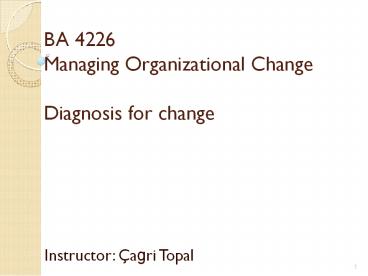BA 4226 Managing Organizational Change Diagnosis for change PowerPoint PPT Presentation
1 / 21
Title: BA 4226 Managing Organizational Change Diagnosis for change
1
BA 4226Managing Organizational
ChangeDiagnosis for change
- Instructor Çagri Topal
2
Diagnostic tools and images
- Director evaluating relationships between
different change variables - Navigator mapping the environment
- Caretaker obtaining some insights about the
environment - Coach developing the competencies needed
- Interpreter understanding different perspectives
and frameworks of stakeholders - Nurturer not using such tools
3
Models
- Implicit
- Providing insights based on experience
- Based on limited experience
- Not known to others
- Explicit
- Transforming complexity into simplicity
- Identifying most important activities
- Constituting a common language
- Providing guidance for change
4
Six-box organizational model (w)
- Purposes
- Structure
- Rewards
- Helpful mechanisms
- Relationships
- Leadership
5
7-S framework (w)
- Structure
- Strategy
- Systems
- Style
- Staff
- Skills
- Superordinate goals
6
Star model (w)
- Strategy
- Structure
- Processes and lateral capability
- Rewards systems
- People practices
7
Congruence model (w)
- Task
- Individuals
- Formal organizational arrangements
- Informal organization
8
Burke-Litwin model (w)
- Environment
- Mission and strategy
- Leadership
- Organizational culture
- Structure
- Management practices
- Systems (policies and procedures)
- Work unit climate
- Task requirements and individual skills/abilities
- Motivation
- Individual needs and values
- Individual and organizational performance
9
Four-frame model (w)
- Structural frame
- Human resource frame
- Political frame
- Symbolic frame
10
Diagnosis by image (w)
- Describing the organization with an image
- Discussing the details of the image
11
PESTEL framework (c)
- External environment
- Political factors
- Economic factors
- Social factors
- Technological factors
- Environmental factors
- Legal factors
12
Scenario analysis (c)
- Creating future scenarios
- Developing different assumptions
- Determining change needs in each scenario
13
Gap analysis (c)
- Where are we now?
- Where do we want to get to?
- How can we get there?
14
Elements of strategy (c)
- Arenas
- Vehicles
- Differentiators
- Staging
- Economic logic
15
Strategic inventory (c)
- Identifying managers assumptions and beliefs
about the environment - Identifying inconsistencies between managers
assumptions and actual environmental variables
16
Newsflash exercise (c)
- Gathering the specific views of managers on
change - Avoiding categorization of managers views
17
Cultural web (c)
- Paradigm
- Rituals and routines
- Stories
- Symbols
- Control systems
- Power structures
- Organizational structure
18
Structural dilemmas (c)
- Differentiation vs. integration
- Gap vs. overlap
- Underuse vs. overload
- Lack of clarity vs. lack of creativity
- Excessive autonomy vs. excessive interdependence
- Too loose vs. too tight
19
Boundaryless organization (c)
- Factors
- Speed
- Flexibility
- Integration
- Innovation
- Boundaries
- Vertical
- Horizontal
- External
- Geographic
20
Stakeholder analysis (r)
- Identify stakeholders
- Assess each stakeholders capacity
- Check each stakeholders track record
- Assess each stakeholders interest
- Identify interested and influential stakeholders
- Find out each stakeholders role
21
Force-field analysis (r)
- Define the problem
- Determine the restraining forces
- Determine the driving forces
- Identify possible outcomes

